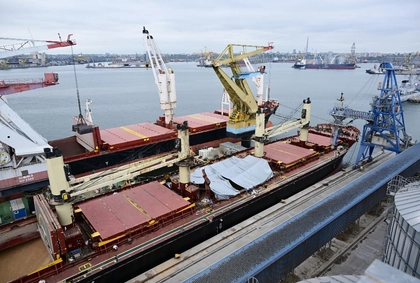The US will discuss details on how best to use frozen Russian Central Bank assets of $280 billion with Germany Wally Adeyemo, the US Deputy Secretary of the Treasury, said during a briefing to reporters on May 29 in Kyiv.
The US will find a solution to which all G-7 partners can agree, ensuring that it will “unlock economic value and have a meaningful value” for Ukraine, Adeyemo said.
JOIN US ON TELEGRAM
Follow our coverage of the war on the @Kyivpost_official.
“We spoke with Ukraine officials about our expectations and to make sure how we can unlock their value so that Ukraine has the resources to pay for the damage from Russia,” he added.
Adeyemo noted that the European Union has already decided to use taxes on excess profits from frozen Russian assets to support Ukraine. G-7 finance ministers are also looking for alternative options to unlock more frozen assets, not just the tax it has accrued. Negotiations which are intended to come to a final dewill take place on June 13.
Currently Germany has opposed suggestions that all assets should be confiscated despite there being clear legal grounds to do so, according to Kyiv Post sources in Ukraine’s government.
The assets of Russian central Bank were immobilised by western governments in response to Russia’s 2022 full-scale invasion of Ukraine. All but $5 billion, which is are located in the US, are held in Europe.
$191billion of Russia’s central bank assets are held by Euroclear, a clearing house situated in Brussels. In February it reported €4.4 billion ($4.75 billion) of interest had been generated by the funds which could provide Belgium with €1.085 billion ($1.17 billion) in taxes, according to The Guardian.

EBRD, Aon Launch War Risk Insurance to Cover Ukraine’s Domestic Cargo
It has been suggested that Ukraine may also receive funds arising from Russia’s frozen assets in the form of a loan, but “the burden of a loan will not fall on Ukraine”, Adeyemo said in answer to journalists’ questions.
He also said that Ukraine must do more to raise resources itself by making its economy sustainable if the war endures for longer. However, the US will do its best to ensure the war would “finish as soon as possible”.
Adeyemo outlined a “to-do list” for economic and anti-corruption reforms Ukraine needs to address, which could also attract private sector businesses to stay in the country. He referred to several international businesses such as Nestle which had committed to stay at least until the end of the year.
“We should also make sure Ukraine has resources to invest in infrastructure here. To do that, they need to have access to Russian sovereign assets”, Adeyemo said.
Building up infrastructure and investing in the country should be the key aims of moneys derived from Russian assets since the US does not want Ukraine to “burn” the potential resource, according to Adeyemo.
Although Western leaders achieved success in delivering 12 packages of sanctions against Russia. The Kremlin is learning how to evade sanctions, but that comes with a price. In Russia’s case, these result in higher prices, increased shipping costs or the use of funds to buy and maintain a shadow fleet and the need to put new insurance schemes in place to compensate for loss or damage of the ships and their cargo.
Despite these issues Russia is still expanding its dedicated military industry. Following the invasion, Russia has increased its military spending from 3 percent of GDP to 6.7 percent and is turning to Chinese dual-use products as it aims to “build more weapons fast,” Adeyemo said.
You can also highlight the text and press Ctrl + Enter






